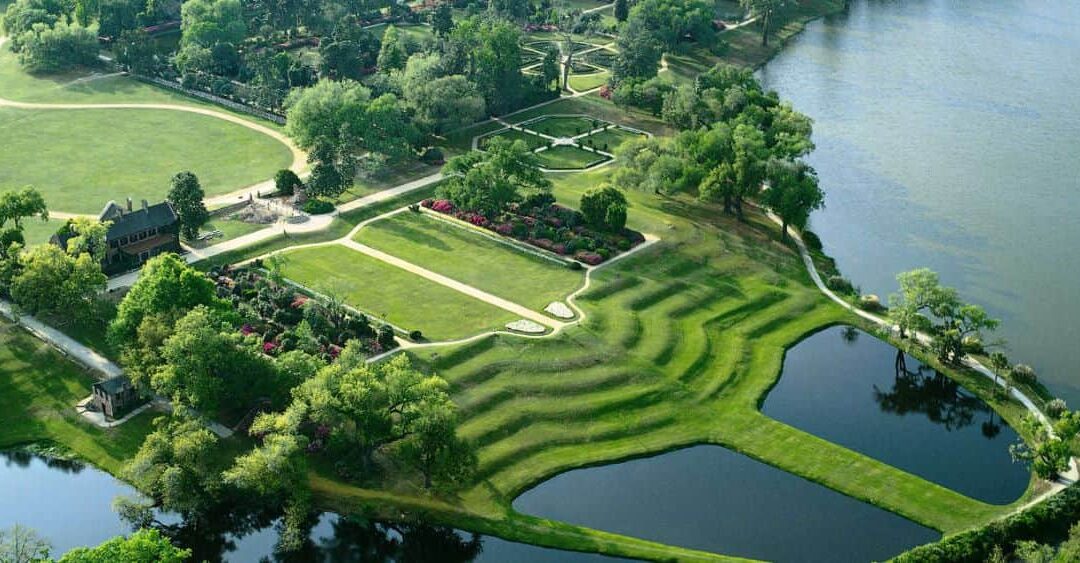About Author & Guest Blogger, Lee Dunn
“Lee C. Dunn has researched and spoken about Southern history, garden and landscape history, and genealogy for more than twenty years. She has been deeply involved in promoting the preservation and awareness of Southern gardens and landscapes for fifteen years though The Garden Club of Georgia and the Southern Garden History Society. Dunn lives in Atlanta, Georgia.” Bio from Mercer University Press
Gardens and Historic Plants of the Colonial Era
The colonial era of gardens in America is defined as the period between 1607, the founding and first permanent English settlement in America at Jamestown, and 1840. Although this doesn’t conform to the historical context of our nation, gardens changed little in America until the Victorian era.
Colonial garden styles vary depending upon wealth and geography. Rural poor and middle-class colonial gardens were smaller, less formal and concentrated more on the necessities of life with little ornamentation or distinct design. A fine example of a rural garden in the south would be the Tullie Smith House Garden at the Atlanta History Center.
Colonial gardens also fall into two distinct categories; kitchen gardens with vegetables and herbs, and pleasure gardens. Features typical of a pleasure garden might include formality with geometric designs, featuring avenues and walkways surrounding parterres, with fenced enclosures overall.
Wealthy landowners particularly in the South, created large expansive landscapes containing cash crops such as tobacco, cotton or rice. Most developed along major waterways to facilitate the movement of crops to market. These wealthy landowners built formal parterre gardens facing the waterside of the estate and they combined these formal constructs with more naturalistic designs made popular by Lancelot “Capability” Brown (1716-1783) which were coming into vogue in Europe in the 1700’s. Both Thomas Jefferson and George Washington used the formal and the naturalistic styles in their gardens that can be seen at Monticello and Mount Vernon respectively.
Ornamental plants commonly used during the colonial garden period
This is a brief list of easily found plant material commonly used in colonial gardens.
Trees
Acer pensylvanicum–striped maple
Acer rubrum–red maple
Aesculus hippocastanum–horsechestnut
Aesculus pavia–red buckeye
Cercis canadensis–eastern redbud
Chionanthus virginicus–white fringe tree
Cladrastis kentukea–yellowwood
Cornus florida–flowering dogwood
Cornus mas–cornelian cherry dogwood
Crataegus phaenopyrum–Washington hawthorn
Franklinia alatamaha–franklin tree
Gymnocladus dioicus–Kentucky coffee tree
Halesia carolina–Carolina silverbell
Ilex opaca–American holly
Juniperus virginiana–eastern red cedar
Liriodendron tulipifera–tulip poplar
Magnolia grandiflora–southern magnolia
Nyssa sylvatica–black tupelo
Platanus occidentalis–sycamore
Stewartia malacodendron–silky stewartia
Perennials
Crocus vernus–Dutch crocus
Hyacinthus orientalis–hyacinth
Iris pallida–sweet iris
Monarda didyma–bee balm
Narcissus pseudo-narcissus–common daffodil
Primula vulgaris–common primrose
Rudbeckia hirta–black-eyed Susan
Tulipa spp.–tulips
Viola tricolor–Johnny-jump-up
Yucca filamentosa–yucca
Shrubs
Buxus sempervirens–common boxwood
Buxus sempervirens ‘Suffruticosa’-edging boxwood
Callicarpa americana–beautyberry
Calycanthus floridus–Carolina allspice
Fothergilla gardenii–dwarf fothergilla
Hibiscus syriacus–rose of Sharon
Hydrangea arborescens–smooth hydrangea
Itea virginica–Virginia sweetspire
Kalmia latifolia–mountain laurel
Syringa vulgaris–lilac
Vines & Groundcovers
Campsis radicans–trumpetcreeper
Clematis virginiana–Virginsbower
Hypericum calycinum–St. Johnswort
Lonicera sempervirens–trumpet honeysuckle
Parthenocissus quinquefolia–Virginia creeper
Vinca minor–common periwinkle
Wisteria frutescens–American wisteria
Annuals
Celosia cristata–cockscomb
Centaurea cyanus–bachelor’s button
Coreopsis grandiflora–tickseed
Delphinium consolida–larkspur
Dianthus caryophyllus–annual carnation
Digitalis purpurea–foxglove (biennial)
Mirabilis jalapa–four-o’clock
Tagetes erecta–African marigold
Tagetes patula–French marigold
Tropaeolum majus–nasturtium
Platanus occidentalis—sycamore
Bibliographic Sources and Links for Colonial Era Gardens and Plants
Gardens and Historic Plants of the Antebellum South, James R. Cothran
For Every House A Garden: A Guide for Reproducing Period Gardens, R. and J. Favretti
Restoring American Gardens, An Encyclopedia of Heirloom Ornamental Plants 1640-1940, Denise Wiles Adams
The Gardens of Colonial Williamsburg, M. Kent Brinkley and Gordon Chappell
Washington’s Gardens at Mount Vernon, Landscape of the Inner Man, Mac Griswold
Thomas Jefferson’s Monticello, The Thomas Jefferson Foundation
Plants of Colonial Days, Raymond L. Taylor
The Southern Garden History Society, http://southerngardenhistory.org/resources/plant-lists/
Sources for the Purchase of Historic Plants
The Thomas Jefferson Center for Historic Plants, https://www.monticello.org/house-gardens/center-for-historic-plants/
Oldest Seed house in America, www.landrethseeds.com
Antique Rose Emporieum, https://antiqueroseemporium.com
For Antique bulbs, www.OldHouseGardens.com
Blog Featured Image
The featured image is an aerial view of Middleton Place, South Carolina, https://www.middletonplace.org/explore/gardens/

